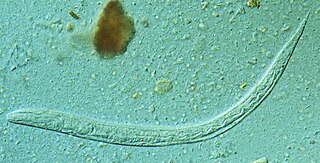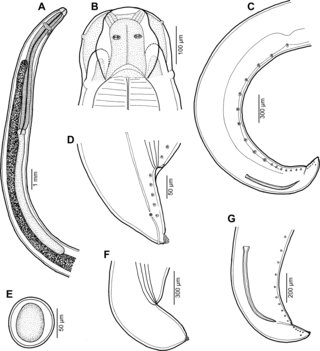
Strongyloides stercoralis is a human pathogenic parasitic roundworm causing the disease strongyloidiasis. Its common name in the US is threadworm. In the UK and Australia, however, the term threadworm can also refer to nematodes of the genus Enterobius, otherwise known as pinworms.

The Caenophidia are a derived clade of alethinophidian snakes, which contains over 80% of all the extant species of snakes. The largest family is Colubridae, but it also includes at least seven other families, at least four of which were once classified as "Colubridae" before molecular phylogenetics helped us understand their relationships. It has been found to be monophyletic.
Cylicocyclus nassatus is a very common species of cyathostomin, which are important intestinal parasites of horses. Cyathostomins, including C. nassatus, are nematodes.

Python is a genus of constricting snakes in the Pythonidae family native to the tropics and subtropics of the Eastern Hemisphere.

The pinworm, also known as threadworm or seatworm, is a parasitic worm. It is a nematode (roundworm) and a common intestinal parasite or helminth, especially in humans. The medical condition associated with pinworm infestation is known as pinworm infection (enterobiasis) or less precisely as oxyuriasis in reference to the family Oxyuridae.

Simalia tracyae, the Halmahera python, is a species of python found only on the Indonesian island of Halmahera. It belongs to the family Pythonidae and the genus Simalia. This snake was previously believed to have belonged to the Simalia amesthistina species; however, studies in recent years have caused scientists to distinguish between the two types of snakes, resulting in the reclassification of the Halmahera python as its own species.

Huffmanela is a genus of parasitic nematodes, belonging to the family Trichosomoididae.
Paratrichodorus is a genus of terrestrial root feeding (stubby-root) nematodes in the Trichodoridae family (trichorids), being one of five genera. They are economically important plant parasites and virus vectors. The females are didelphic, and are distributed worldwide.
Trichodoridae is a family of terrestrial root feeding nematodes, being one of two that constitute suborder Triplonchida. They are economically important plant parasites and virus vectors.
Strongyloides lutrae is a parasitic roundworm infecting the small intestine of the otter, Lutra canadensis. It was first described from Louisiana.
Strongyloides dasypodis is a parasitic roundworm infecting the large intestine of the armadillo, Dasypus novemcinctus. It was first described from Louisiana.
Strongyloides ardeae is a parasitic roundworm infecting the small intestine of yellow-crowned night heron, Nyctanassa violacea, and eastern green heron, Butorides virescens. It was first described from Louisiana.
Strongyloides physali is a parasitic roundworm infecting the large intestine of the Gulf Coast toad. It was first described from Louisiana.
Strongyloides serpentis is a parasitic roundworm infecting the intestine of the green water snake, hence its name. It was first described from Louisiana.
Strongyloides procyonis is a parasitic roundworm infecting the small intestine of the raccoon, Procyon lotor, hence its name. It was first described from Louisiana. It is morphologically similar to S. stercoralis, and as such infections of S. procyonis in humans, dogs, and other animals might be mistaken for the former.
Pterygodermatites peromysci is an intestinal parasitic nematode in the genus Pterygodermatites of the family Rictulariidae.

František Moravec is a Czech parasitologist who specialises on the Nematodes, especially the nematodes parasites of fishes. His research is mainly in the field of taxonomy of the Nematoda.

Hysterothylacium is a genus of parasitic roundworms in the family Raphidascarididae. As of 2020 it consists of over 70 species and is considered one of the largest of the ascaridoid genera parasitising fish.
Ophidascaris robertsi is a nematode usually parasitic in the carpet python. It is found in Australia and Papua New Guinea. Pythons serve as the typical hosts for Ophidascaris robertsi, which has an indirect life cycle. The adult parasites develop nodular masses in the oesophagus and stomach of carpet pythons and place a small piece of their anterior bodies into the nodules that protrude from the digestive mucosa. When endemic parasites like Ophidascaris robertsi infect local fauna, the pathological changes that follow are frequently self-limiting or do not result in illness.







